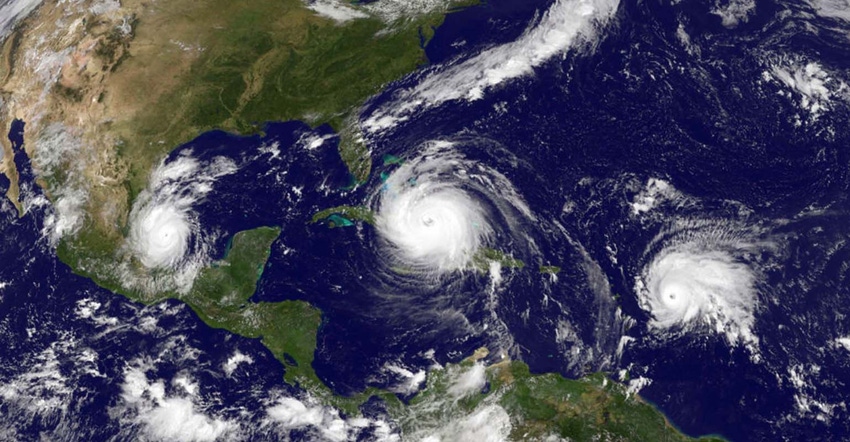
by Megan Durisin
Hurricane Irma probably will ravage Florida’s orange groves and sugar-cane crops once the powerful storm strikes the state this weekend. But the damage may not end there for the agriculture industry in the Southeast. Heavy rain and wind is projected to keep moving north into Georgia and reach parts of Tennessee, Alabama and the Carolinas, putting some of the top U.S. producers of chicken, cotton and hogs at risk.
"You’ve got your citrus and vegetable issue in Florida right away, and then as it moves on up into north Florida and Georgia, that’s right in the heart of peanut and cotton country, and soybean and corn country in southwest Georgia, primarily," Agriculture Secretary Sonny Perdue, a Georgia native and former state governor, told reporters in Washington Friday.
Cotton
Georgia is the country’s second-largest cotton producer. Most of the crop is in the southwest part of the state, with the harvest still a few weeks away, said Keith Brown, president of cotton brokerage Keith Brown & Co. While cotton fields will be able to withstand several inches of rain and strong winds, gusts topping 45 miles per hour could cause plants to twist, complicating harvest, he said. Hurricane season has boosted prices, with December futures traded in New York soaring more than 10% in the past two weeks. Still, U.S. farmers boosted plantings by a fifth this year, which may help to offset losses. “If we were to lose 1 million bales between Harvey and Irma, we still have cotton aplenty,” Brown said.
Livestock
Georgia and Alabama are two of the top chicken-producing states. While the birds are primarily raised indoors, poultry facilities need a steady supply of electricity and feed, and processing could slow if the animals can’t be transported. Mississippi-based producer Sanderson Farms Inc. is taking precautions at plants in Georgia and North Carolina, and Arkansas-based meat company Tyson Foods Inc. is monitoring the impact of the storm. Pork giant Smithfield Foods Inc. said it’s prepared for Irma and will monitor the levels in its manure lagoons -- the giant pools of pig waste are a concern anytime there’s flooding close by. The latest trajectory shows the heaviest rainfall missing most of North Carolina, the country’s second-largest hog-raising state.
Grain, soy
While most corn and soybeans are raised in the Midwest, southeastern states also grow the crops, which could be damaged by Irma as they await harvesting. Georgia had collected most of its corn and 43% of its soybeans as of Sept. 3, while fields in Tennessee, Kentucky, Alabama and the Carolinas were less advanced, government data show. Irma’s center will move toward Atlanta early next week, bringing high winds and as much as 8 inches of rain to central-eastern Georgia into eastern South Carolina. That may damage soybeans awaiting harvest, according to Kyle Tapley, senior meteorologist at MDA Weather Services in Gaithersburg, Maryland.
Shipping
In Georgia, ports at Savannah and Brunswick will be closed Sept. 9-12, according to the state’s port authority website. The region ships commodities including poultry, cotton, wood pulp, nuts and animal feed. A sizable amount of poultry and meat exports move through Atlantic ports and any threat to that supply chain will have a “detrimental impact” on the profitability of soybean farmers, said Mike Steenhoek, executive director of the Soy Transportation Coalition. Thirty-two percent of U.S. poultry exports are shipped through Savannah and 18% of U.S. soybean oil exports depart from the port region in Norfolk, Virginia, according to the industry group, citing U.S. Department of Agriculture data. “The hope is that the affected areas will simply incur delays in loading and unloading vessels,” Steenhoek said. “If the hurricane results in damage and destruction to the infrastructure and export facilities themselves, the consequences will be more long-lasting.”
Other crops
States in the path of the storm are also among the largest growers of tobacco, sweet potatoes, peanuts and pecans. Peaches and blueberries were harvested earlier this summer.
--With assistance from Jeff Wilson, Shruti Date Singh, Marvin G. Perez, Alan Bjerga and Jen Skerritt.
To contact the reporter on this story: Megan Durisin in Chicago at [email protected]
To contact the editors responsible for this story: Simon Casey at [email protected]
Steve Stroth
© 2017 Bloomberg L.P
About the Author(s)
You May Also Like




